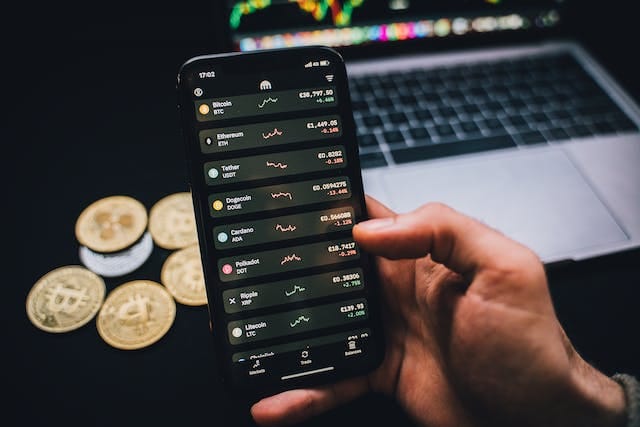Understanding the Impact of Economic Indicators on Forex Trading
Gain insights into the impact of economic indicators on Forex trading. Understand how key indicators influence currency markets, aiding informed trading decisions.

Introduction to Economic Indicators in Forex Trading
As a forex trader, understanding the impact of economic indicators is crucial to making informed decisions and maximizing profits. Economic indicators are key data points that provide insights into a country's economic performance. These indicators can include reports on employment, inflation, GDP, and trade balances, among others. In the world of forex trading, these indicators play a significant role in shaping market movements and influencing currency values.
When it comes to forex trading, economic indicators serve as a barometer for the overall health of a country's economy. For instance, a strong employment report can signal economic growth and potentially lead to a stronger currency value. On the other hand, high inflation rates may devalue a currency, impacting forex trades. By analyzing and understanding these indicators, traders can gain valuable insights into market trends and make more informed trading decisions.
In the fast-paced world of forex trading, staying updated on economic indicators is essential. Traders closely monitor economic calendars, which provide schedules of upcoming releases of key economic data. These calendars help traders plan their strategies and anticipate market movements based on the expected impact of the upcoming indicators. Additionally, being aware of the historical impact of certain indicators can provide valuable context for interpreting current data and making informed trading decisions.
Key Economic Indicators and their Impact on Forex Markets

Several key economic indicators have a significant impact on forex markets. One of the most closely watched indicators is the Gross Domestic Product (GDP) report, which measures a country's economic output. A strong GDP growth rate is generally seen as positive for a currency, as it indicates a healthy and growing economy. Conversely, a lower-than-expected GDP can lead to a depreciation of the currency.
Another critical economic indicator is the unemployment rate. A high unemployment rate can signal economic weakness and potential currency devaluation, while a declining unemployment rate may lead to a stronger currency. Additionally, inflation reports, such as the Consumer Price Index (CPI) and Producer Price Index (PPI), play a significant role in forex trading. High inflation rates can erode the value of a currency, while low inflation rates are generally seen as positive for a currency's strength.
Trade balance and retail sales reports are also essential economic indicators for forex traders. A positive trade balance, indicating that a country's exports exceed its imports, can lead to a stronger currency value. Similarly, robust retail sales figures can signal consumer confidence and economic strength, potentially leading to a stronger currency. By closely monitoring these key economic indicators, forex traders can gain valuable insights into potential market movements and adjust their trading strategies accordingly.
Using Economic Indicators to Forecast Forex Trends
One of the primary benefits of understanding economic indicators in forex trading is the ability to forecast potential market trends. By analyzing historical data and the impact of various economic indicators on currency values, traders can develop strategies to capitalize on potential market movements. For example, if a country's GDP growth rate consistently leads to a strengthening of its currency, traders can anticipate and position themselves for potential gains when positive GDP reports are released.
Additionally, understanding the interplay between different economic indicators can provide valuable insights into broader market trends. For instance, a combination of strong GDP growth, low unemployment, and positive retail sales figures may collectively contribute to a strengthening of a country's currency. By recognizing these interdependencies and their impact on forex markets, traders can develop more comprehensive trading strategies and make more informed decisions.
Furthermore, utilizing technical analysis in conjunction with economic indicators can enhance traders' ability to forecast forex trends. By combining historical price data with the release of key economic indicators, traders can identify potential patterns and trends, adding another layer of insight to their trading decisions. This holistic approach to forex trend forecasting can help traders anticipate and capitalize on market movements with greater precision.
The Role of Central Banks in Economic Indicators and Forex Trading
Central banks play a pivotal role in shaping economic indicators and influencing forex trading. One of the key responsibilities of central banks is setting monetary policy, including decisions on interest rates and money supply. These policy decisions have a direct impact on a country's economic indicators and, consequently, on forex markets. For example, a central bank's decision to raise interest rates can lead to a stronger currency, while a rate cut may lead to depreciation.
Central banks also have the power to intervene in forex markets to stabilize their currencies or address economic imbalances. Such interventions can impact currency values and alter market dynamics, making it essential for forex traders to stay informed about central bank actions and policy announcements. Additionally, central bank speeches and statements are closely monitored by forex traders for insights into future monetary policy decisions, as these can significantly influence currency values.
In the context of economic indicators, central bank statements and policy decisions are critical factors that traders consider when analyzing and forecasting forex trends. Understanding the role of central banks and their influence on economic indicators is essential for developing effective trading strategies and managing risks in the dynamic forex market.
Strategies for Trading Based on Economic Indicators
Trading based on economic indicators requires a well-defined strategy and a comprehensive understanding of market dynamics. One common strategy is to capitalize on the immediate impact of key economic releases. When significant economic indicators, such as GDP or employment reports, are released, the forex market often experiences sharp movements as traders react to the new data. Traders who are well-prepared and have a clear plan in place can take advantage of these rapid market shifts to capitalize on short-term trading opportunities.

Another popular strategy is trend trading based on economic indicators. By identifying long-term trends influenced by economic data, traders can position themselves to benefit from sustained market movements. For example, if a country consistently reports strong GDP growth, traders may adopt a long-term bullish stance on its currency, capitalizing on the potential for sustained appreciation.
Additionally, some traders use a range trading strategy based on economic indicators. By identifying currency pairs that are influenced by specific economic indicators and trading within a defined price range, traders can capitalize on short-term market fluctuations while minimizing risk. This strategy requires a deep understanding of the impact of economic indicators on specific currency pairs and careful analysis of historical price movements.
Risks and Challenges in Trading Based on Economic Indicators
While trading based on economic indicators offers significant opportunities, it also comes with inherent risks and challenges. One of the primary risks is the potential for market volatility following the release of key economic data. Sharp and unpredictable price movements can lead to significant losses if traders are not adequately prepared or if their trading strategies are not well-defined.
Another challenge in trading based on economic indicators is the potential for market expectations to already be priced into currency values before the actual release of the data. In such cases, even if the economic indicator meets or exceeds expectations, the market may not react as anticipated, leading to unexpected outcomes for traders. Navigating these market dynamics requires a combination of thorough analysis, risk management strategies, and the ability to adapt to changing market conditions.
Furthermore, traders must be mindful of the interconnected nature of global economies and the potential for unexpected events to impact economic indicators and forex markets. Geopolitical events, natural disasters, and unexpected policy shifts can all influence economic indicators and lead to market disruptions. Managing these external risks and staying agile in response to changing market conditions are essential for traders focused on economic indicators.
Tools and Resources for Tracking Economic Indicators
To effectively track and analyze economic indicators for forex trading, traders have access to a wide range of tools and resources. Economic calendars are invaluable for staying informed about upcoming releases of key economic data. These calendars provide schedules of when various indicators will be released, along with consensus forecasts and historical data, enabling traders to plan their trading strategies around these events.
In addition to economic calendars, traders can utilize financial news outlets and analysis platforms to stay updated on economic indicators and their potential impact on forex markets. These resources offer in-depth analysis, expert insights, and real-time updates on economic data releases, providing traders with the information they need to make informed trading decisions.
Moreover, forex trading platforms often provide access to advanced charting tools and technical analysis indicators, allowing traders to overlay economic data releases onto price charts and identify potential correlations and trends. By leveraging these tools, traders can gain a deeper understanding of how economic indicators influence market movements and incorporate this knowledge into their trading strategies.
Case Studies: Economic Indicators' Impact on Forex Trading
To illustrate the real-world impact of economic indicators on forex trading, let's consider a few case studies that highlight the influence of key economic data releases on currency values and market movements.
Case Study 1: Non-Farm Payrolls Report
The monthly Non-Farm Payrolls (NFP) report in the United States is a highly anticipated economic indicator that has a significant impact on forex markets. The NFP report provides insights into the employment situation in the US, including the number of new jobs created and the unemployment rate. A positive NFP report, indicating strong job creation and declining unemployment, often leads to a strengthening of the US dollar, as it signals economic growth and potential interest rate hikes by the Federal Reserve.
Conversely, a weaker-than-expected NFP report can lead to a depreciation of the US dollar, as it suggests economic weakness and may prompt the Federal Reserve to consider monetary policy adjustments to stimulate the economy. Forex traders closely monitor the release of the NFP report and prepare for potential market volatility as they position themselves based on the report's implications for the US dollar and currency pairs involving the USD.
Case Study 2: European Central Bank (ECB) Monetary Policy Decision
The monetary policy decisions of the European Central Bank (ECB) have a substantial impact on forex markets, particularly for currency pairs involving the euro. When the ECB announces interest rate decisions or provides guidance on future policy actions, forex traders pay close attention to the potential impact on the euro's value. A hawkish stance by the ECB, indicating a potential interest rate hike or tightening of monetary policy, can lead to a strengthening of the euro.
Conversely, a dovish stance by the ECB, suggesting accommodative monetary policy measures or potential rate cuts, may lead to a depreciation of the euro. Traders analyze the ECB's policy statements and press conferences to gauge the central bank's outlook on economic indicators such as inflation, growth, and employment, as these factors influence the ECB's policy decisions and, in turn, affect forex trading opportunities.
Economic Indicators and Global Events
Understanding the interplay between economic indicators and global events is essential for forex traders. Global events, such as geopolitical tensions, trade agreements, and natural disasters, can impact economic indicators and lead to significant market movements. For example, geopolitical tensions in key oil-producing regions can influence oil prices, impacting inflation rates and trade balances for oil-importing countries, which, in turn, can affect currency values.
Similarly, trade agreements and tariffs can influence trade balances and currency values, as changes in trade dynamics between countries can impact economic indicators such as exports and imports. Traders must stay informed about global events and their potential implications for economic indicators, as these external factors can significantly influence forex market trends and trading opportunities.
Conclusion
In conclusion, economic indicators play a vital role in shaping forex market movements and influencing currency values. By understanding key economic indicators, their impact on forex trading, and the strategies for trading based on economic data, traders can gain valuable insights into market trends and make informed trading decisions. The role of central banks, risks and challenges in trading based on economic indicators, and the tools and resources available for tracking economic data are all essential considerations for forex traders focused on economic indicators.
As global events continue to impact economic indicators and forex markets, staying informed and adapting to changing market conditions are crucial for traders seeking to capitalize on economic data-driven trading opportunities. By leveraging the knowledge and insights gained from economic indicators, traders can develop effective strategies, manage risks, and navigate the dynamic world of forex trading with greater confidence.
CTA: Stay informed and enhance your forex trading strategies by staying updated on key economic indicators and their impact on global markets. Explore economic calendars, analysis platforms, and charting tools to make informed trading decisions.




